
Fowey is a port town and civil parish at the mouth of the River Fowey in south Cornwall, England, United Kingdom. The town has been in existence since well before the Norman invasion, with the local church first established some time in the 7th century; the estuary of the River Fowey forms a natural harbour which enabled the town to become an important trading centre. Privateers also made use of the sheltered harbourage. The Lostwithiel and Fowey Railway brought China clay here for export.

The Bodmin and Wenford Railway is a 6 miles 12 chains (9.9 km) heritage railway at Bodmin in Cornwall, England. Its headquarters are at Bodmin General railway station and it connects with the national rail network at Bodmin Parkway.

The Swanage Railway is a railway branch line from near Wareham, Dorset to Swanage, Dorset, England, opened in 1885 and now operated as a heritage railway.

The Atlantic Coast Line is a 20+3⁄4-mile (33 km) Network Rail branch line which includes a community railway service in Cornwall, England. The line runs from the English Channel at Par, to the Atlantic Ocean at Newquay.

Par is a village and fishing port with a harbour on the south coast of Cornwall, England, United Kingdom. The village is situated in the civil parish of Tywardreath and Par, although West Par and the docks lie in the parish of St Blaise.

The Bodmin and Wadebridge Railway was a railway line opened in 1834 in Cornwall, England, United Kingdom. It linked the quays at Wadebridge with the town of Bodmin and also to quarries at Wenfordbridge. Its intended traffic was minerals to the port at Wadebridge and sea sand, used to improve agricultural land, inwards. Passengers were also carried on part of the line.

Lostwithiel railway station serves the town of Lostwithiel in Cornwall, England. It is 277 miles 36 chains from the zero point at ‹See TfM›London Paddington measured via Box and Plymouth Millbay. Great Western Railway operates the station along with every other station in Cornwall.

The Cornwall Railway was a 7 ft 1⁄4 in broad gauge railway from Plymouth in Devon to Falmouth in Cornwall, England, built in the second half of the nineteenth century. It was constantly beset with shortage of capital for the construction, and was eventually forced to sell its line to the dominant Great Western Railway.
The Newquay and Cornwall Junction Railway was a 7 ft broad gauge railway intended to link the Cornwall Railway with the horse-worked Newquay Railway. It opened a short section to Nanpean in 1869, the remainder being built by the Cornwall Minerals Railway who took over the company in 1874. Its main traffic has always been china clay.

St Blazey engine shed is located in Par, Cornwall, United Kingdom, although it is named after the adjacent village of St Blazey. It was built in 1874 as the headquarters of the Cornwall Minerals Railway but for many years was a depot of the Great Western Railway. The current depot operator is DB Cargo and the depot TOPS code is BZ.
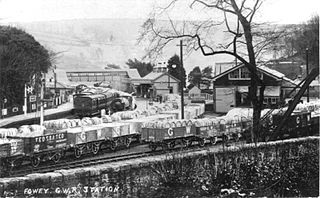
Fowey railway station was a station in Fowey, Cornwall from 1874 until 1965. The rail connection to the docks at Carne Point remains open for china clay traffic.
Golant railway station was opened on 1 July 1896 by the Great Western Railway. It was a simple platform on the waterside at the south end of Golant village, next to a level crossing that gave access to a slipway.
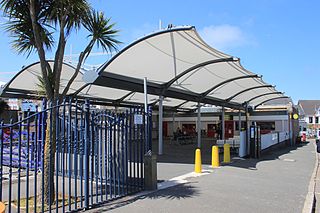
Newquay railway station serves the town and seaside resort of Newquay in Cornwall, England. It is the terminus of the Atlantic Coast Line from Par, 302 miles 49 chains from the zero point at ‹See TfM›London Paddington measured via Box and Plymouth Millbay. The station is situated in the heart of Newquay, close to the town centre itself and the beaches. The station is managed by Great Western Railway which operates local branch line services to and from Par. In the summer, there are also services to and from London.
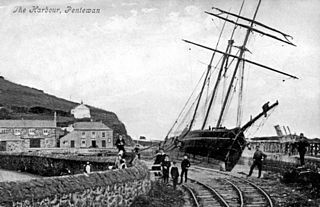
The Pentewan Railway was a 2 ft 6 in narrow gauge railway in Cornwall, England. It was built as a horse-drawn tramway carrying china clay from St Austell to a new harbour at Pentewan, and was opened in 1829. In 1874 the line was strengthened for locomotive working. It finally succumbed to more efficient operation at other ports and closed in 1918.
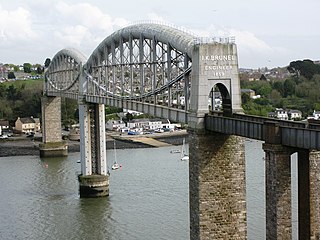
The Cornish Main Line is a railway line in Cornwall and Devon in the United Kingdom. It runs from Penzance to Plymouth, crossing from Cornwall into Devon over the Royal Albert Bridge at Saltash.
The Liskeard and Looe Railway was a railway originally built between Moorswater, in the valley west of Liskeard, and Looe, in Cornwall, England, UK, and later extended to Liskeard station on the Cornish Main Line railway. The first section was opened in 1860 and was owned by the Liskeard and Looe Union Canal Company, whose canal had earlier been built to convey sea sand and lime up the valley of the East Looe River, for the purpose of improving agricultural land.

The Cornwall Minerals Railway owned and operated a network of 45 miles (72 km) of standard gauge railway lines in central Cornwall, England, United Kingdom. It started by taking over an obsolescent horse-operated tramway in 1862, and it improved and extended it, connecting Newquay and Par Harbours, and Fowey. Having expended considerable capital, it was hurt by a collapse in mineral extraction due to a slump in prices. Despite its title, it operated a passenger service between Newquay and Fowey.
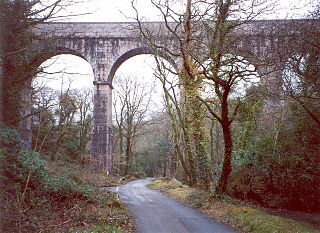
The Treffry Tramways were a group of mineral tramways in Cornwall in the United Kingdom, constructed by Joseph Treffry (1782–1850), a local land owner and entrepreneur. They were constructed to give transport facilities to several mines and pits producing non-ferrous metal, granite and china clay in the area between the Luxulyan Valley and Newquay, and were horse-operated, with the use of water and steam power on inclines, and at first operated in conjunction with the Par Canal and Par Docks, also constructed by Treffry. One of the routes crossed the Luxulyan Valley on a large viaduct, the largest in Cornwall when it was built.

Moorswater railway station was the centre of operations for the Liskeard and Caradon Railway and the Liskeard and Looe Railway. The two railways made an end on junction here. It was the site of the lines' engine shed, also a china clay works which is now used as a cement terminal.
The Cornish China Clay Branches are a number of railway branch lines that serve facilities that produce or process China Clay. The area of Cornwall north of St Austell stretching from Bodmin Moor towards Truro is known for the extraction and processing of commercial volumes of China Clay, and with the expansion of the railways in the 19th century a number of lines were constructed to access various mines and clay-dries. Some branches have closed over the years, but several still operated into the 21st century although much of the China Clay traffic has transferred to road transport. In 2020 rail traffic remained in the shape of regular trains running between Parkandillack and the wharves at Carne Point where the large volumes required to be loaded onto ships for export would make road transport uneconomic.


















